Belcarra Garden Club
BC, Canada

June 2022
Species at Risk… Monarchs need Milkweed!
By Nora Boekhout and Les Bramley
Here’s a disturbing fact: did you know that British Columbia has over 1800 species (including plants) at risk of extinction?
This is more than any other province or territory in Canada!
Loss of habitat, wide spread urbanization, intensive agriculture, and heavy pesticide use has led to a drastic decline in many species.

At this month’s gathering, our Belcarra Garden Club leader, Les Bramley, focused on the plight of the Monarch Butterfly.
The Monarch Butterfly (Danaus plexippus) is certainly one of the most well-known and loved butteries.
It is an international symbol of conservation and nature.
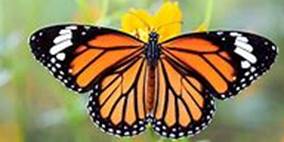
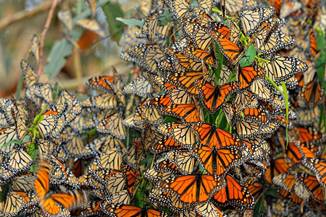
Monarch Butterflies
Most of you will be familiar with the images of hundreds of them in flight or better yet, thousands of them collected on the trees in Mexico! You might also have heard that unlike most butterflies, some of the subspecies travel almost 4,000 kilometers in fall, all the way from Canada to Mexico. It is the only butterfly known to make this two-way migration, as birds do, and it is one of the longest insect journeys in the world. In BC we have a small population that migrates to the Pacific Coast of California. Canada's eastern Monarchs are from the Rockies to the Maritimes.
You may wonder how a little butterfly could manage when their life span is only three to five weeks… it takes five generations to cover the distance to Canada during the spring migration! As they travel, they lay eggs. It takes about four weeks from the eggs hatching, through the caterpillar phase, the chrysalis phase, and then the final metamorphosis into a butterfly. These new Monarchs then takes up the journey. Less common is the so-called super generation of Monarch, those that emerge from their chrysalis as summer ends and live seven or eight months. These take the epic migration to Michoacan, Mexico in the fall. They live there in reproductive diapause until late winter when they begin to breed. The females then fly to the South Eastern US where they lay their eggs. Subsequent generations fly northward in spring. When Monarchs travel in masses of thousands, they play a major role in long distance pollination.
What you may not be aware of, is that 80% of this wonderful species of butterflies has disappeared over the last twenty years! This is truly a shocking decline. The leaders of Mexico, the United States and Canada came together for the North American Leaders Summit in 2014 and actually signed an international agreement for Monarch conservation. In Mexico only 2% of the famous Monarch butterfly Oyamel fir forest remains. In California, an estimated 10 million Monarchs wintered in coastal California in the 1980s. In 2017 the count was about 148,000 Monarchs and in 2018, that number dropped to 28,429.
In BC the Monarch population barely tallied 2,000, which was a 99% drop since 1980. However, in late 2021 the count hit 200,000. Experts aren't sure why yet, so are having some cautious optimism. Likewise, one good news report, from World Wildlife Fund (WWF) Mexico, noted that the number of wintering Monarchs in Mexico jumped by 35 per cent this past December 2021 compared to the previous year.
Why are we so concerned about butterflies? “Butterflies are often described as keystone species because they not only respond quickly to ecological changes, but they also provide insights into the health of the environment they are living in.” (Quote from David Suzuki Where are all the monarchs? B.C. Butterflyway Rangers to use citizen science in 2019 to find out - David Suzuki Foundation) According to Wildlife Preservation Canada, “Many native flowers are not pollinated by bees but by butterflies, whose long proboscis (mouthpart used for feeding) are able to reach deep enough into the flower to pollinate these species.”
No wonder that Les chose this as a subject to investigate!
But what does this have to do with a garden club, you might ask.
A better question is, what can a garden club do to help?
Milkweed Plants
Strangely enough, while the Monarch butterflies seek the nectar of many different plants, they lay their eggs exclusively on milkweed plants. Planting milkweed is one of the best ways that North American gardeners can help the endangered Monarch. Canada is the northernmost range of the milkweed plant, and not many milkweed species can survive our cold winters. If we can propagate it ourselves, an added bonus is that milkweed flowers are popular with other types of butterflies (including swallowtails, fritillary, and skippers), as well as moths, bees, flies, beetles and even hummingbirds.
Milkweed has 120 species! Oh my! Some like full sun and some like some shade. Some will not flower the first year but the caterpillars only eat the green leaves anyway. Monarchs actively search for milkweed plants. Then the females “taste” the plants using their sensory receptors in their antennae and front legs before laying their eggs. Monarchs actually use the toxins in the milkweed sap as one of their defense mechanisms. As the caterpillars eat the milkweed leaves, the cardiac glycoside is absorbed into their tissue. This toxin is retained in the tissue through metamorphosis so it is also present in the adult Monarch butterfly.
Two types of milkweeds are especially good choices for our local gardeners: the Swamp milkweed (Asclepius incarnata) reaches 120cm (48") in height, hardy to Zone 3, and is deer resistant); the Showy Milkweed (Asclepius speciosa) is about 90cm (36") tall, is hardy for zones 3 to 7, and is native from BC to the Maritimes. Both are readily available as seeds from West Coast Seeds and grown plants are also often available at local garden centers, such as Amsterdam Nursery. Butterfly Bush Milkweed (Asclepius tuberosa) is also particularly liked by bees and is hardy to zone 4. The Green Comet Milkweed (Asclepias viridiflora) is another species good to grow in BC. It likes partial shade and is drought tolerant. Milkweed seeds need cold weather to mature. (The seed packages suggest starting them in the refrigerator for a couple weeks!)
Is Swamp Weed invasive? For many years several Asclepius species were listed as invasive weeds because of their sometimes-aggressive spreading by underground rhizomes and their giant dandelion seeds. Growing them in containers is an easy way to avoid this. Additionally, the seeds emerge from very conspicuous pods which are easily removed before they dry and crack.
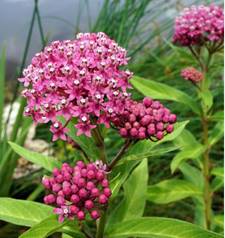 |
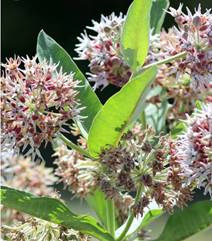 |
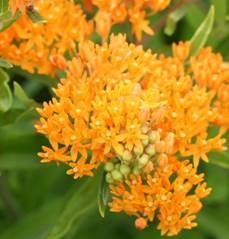 |
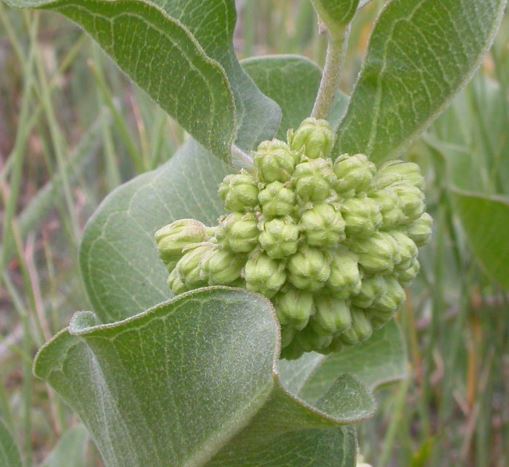 |
|---|---|---|---|
Swamp milkweed |
Showy milkweed |
Butterfly Bush milkweed |
Green comet milkweed |
NO GROW milkweed species
Note that the species Tropical Milkweed (Asclepius curassavica) is a non-native species to California and BC and should be removed if found.
It has the potential of harboring a protozoan parasite Ophyrocystis elektroscirra (Oe) that causes defects in the wings of monarchs. These plants bloom late causing breeding when the Monarchs should be migrating. Another species to avoid is Common Milkweed (Asclepius syriaca) as it is considered a noxious weed.
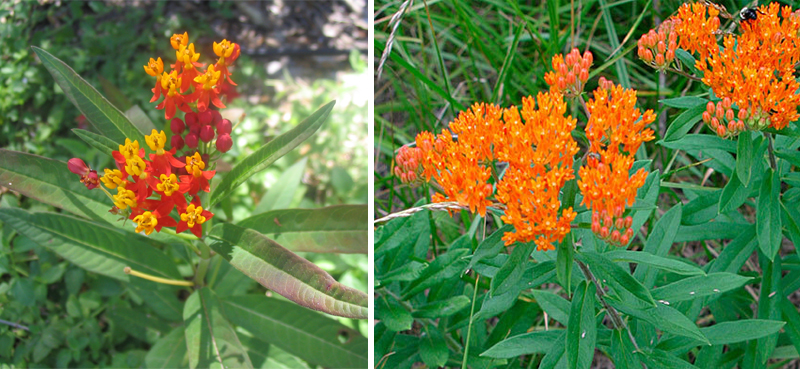
NO GROW (A. curassavica, left) Okay to grow(A. tuberosa, right)
NO GROW Tropical milkweed (A. curassavica, left) can be difficult to distinguish from orange butterflyweed (A. tuberosa, right). Orange butterflyweed is also a low-growing milkweed with bright orange flowers that is native across much of North America. (Photo, Left: Justin Lebar / Wikimedia Creative Commons; Photo, Right: Joshua Mayer / Flickr Creative Commons) |
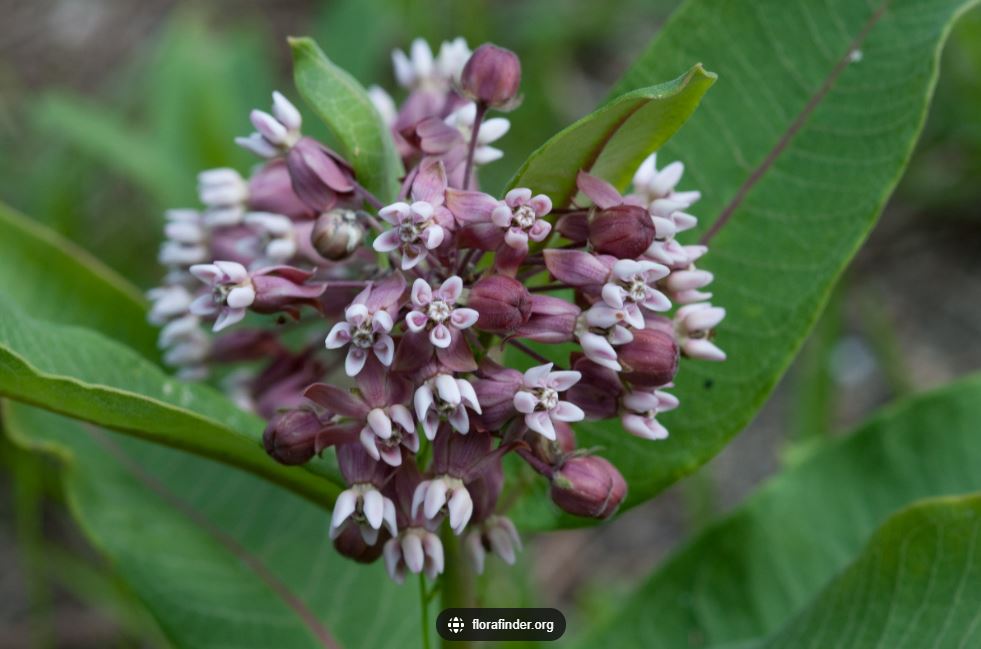 NO GROW - Common Milkweed
NO GROW - Common Milkweed
Other important factors:
1. If you purchase milkweed plants, be sure that they were not treated with pesticides or insecticides at any time.
2. The sap in milkweed plants (cardiac glycoside) is harmful, even toxic, to pets. It can also cause skin and irritation in humans. Wear gloves when handling it.
 |
(Just so I don’t turn you off planting milkweed, many other typical garden plants that can be toxic to pets! Examples: foxglove (abundant in our area!), English Ivy (abundant!) lily of the valley (abundant!), kalanchoe, dogbane, sago palm, oleander, lilies, star of Bethlehem, Calotropis gigantea, aka Giant Milkweed or Crown Flower) |
|---|
The Final Scoop on Gardening for Monarchs
Here’s an inspiring idea to think about: in November 2019 the “Butterflyway Project” won a Nature Inspiration Award from the Canadian Museum of Nature.
By planting native plants in urban habitats, the participants helped provide food and shelter for butterflies, bees, and birds in an increasingly challenging environment. Wouldn’t it be great if our own little community added its own contribution to Mother Earth!
BTW, captive rearing is an important tool for many species but not for monarchs. Research indicates it can negatively impact their migratory capacity. Some commercially produced monarchs have been shown to be genetically distinct from North American lineages.
The Belcarra Garden Club will be exploring this idea, and others, at the July meeting which will delve more into “Planting with Native Plants”.
Maybe those vacant road ends can be revitalized into “Native Plant Community Gardens” (with appropriate fencing and/or signage to warn owners who have pets that are prone to munching as they go!)
LINKS
Monarch Butterflies
Point Pelee National Park, Ontario: and important Canadian stop for Monarchs
https://www.msn.com/en-ca/weather/topstories/wintering-monarch-numbers-rise-by-35-in-mexico-after-steep-declines/ar-AAXNjMx
Mission Monarch, (Space for Life Insectarium, Montreal) is part of an international research and education effort aimed at saving the migratory populations of this endangered species.
https://www.mission-monarch.org/
Journey North: Tracking migrations and seasons
https://journeynorth.org/
Monarchs in California
https://wildlife.ca.gov/Conservation/Invertebrates/Monarch-Butterfly
Here is a very interesting fact sheet on California’s role in protecting monarchs.
https://nrm.dfg.ca.gov/FileHandler.ashx?DocumentID=194943&inline
Monarchs in Mexico
https://journeynorth.org/tm/monarch/SanctuaryFactsOyamel.html
Milkweed
https://savingthemonarch.com/growing-milkweed-in-canada/
West Coast Seeds
https://www.westcoastseeds.com/blogs/garden-wisdom/about-milkweed
Nature Watch
https://www.naturewatch.ca/milkweedwatch/identifying-milkweed/
Tropical Milkweed – one species you do NOT want!
https://monarchjointventure.org/images/uploads/documents/Oe_fact_sheet.pdf

Butterfly Gardens
https://davidsuzuki.org/living-green/how-to-create-a-butterfly-garden/
https://www.wikihow.com/Create-a-Butterfly-Garden
This webpage has a delightful little “garden map”.
https://www.thespruce.com/how-to-make-a-butterfly-garden-4427931
This webpage includes a list of some butterflies and their preferred flowers.
https://wildlifeinformer.com/how-to-make-a-butterfly-garden/
Toxic Plants for Pets
https://spca.bc.ca/news/toxic-plants/
https://www.aspca.org/pet-care/animal-poison-control/toxic-and-non-toxic-plants/d
Painted Lady Butterflies
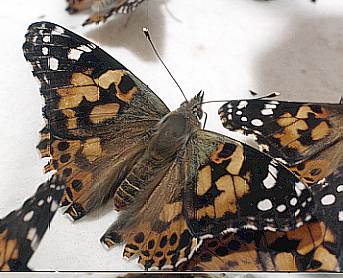 |
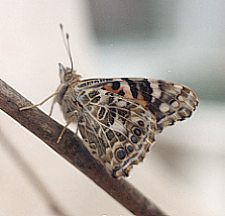 |
|---|
Here in BC, a popular butterfly to raise in a school classroom is the Painted Lady Butterfly.
You can check out our classroom photos of this exciting project! It was one of our class favourites!
PhotoSpot- Painted Lady page 1 (teacherwebshelf.com)
Classroom Animals and Pets - Insects - Butterflies (teacherwebshelf.com)
![]() Back to Belcarra Garden Club
Back to Belcarra Garden Club
![]() Back to Nature's Classroom
Back to Nature's Classroom
This page created June 2002.